AIDAprima
Background
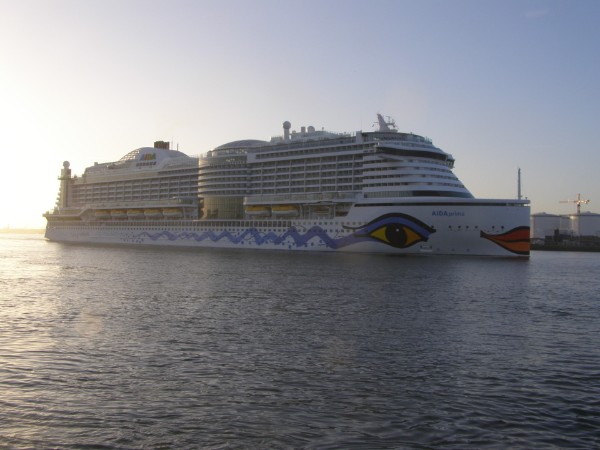
The newest and largest member of the AIDA Cruises fleet, AIDAprima, presented herself to me in the early morning of the 20th of april 2016 at Vlaardingen in The Netherlands. A ship of revolutionairy design and a great addition to the worlds cruising fleet.
After the successfull introduction of the Sphinx-class of ships for the fast-growing AIDA Cruises brand, the company had become the leading cruiseline in northern Europe, totally transforming the German cruisemarket. In origin, the company had been the Deutsche Seereerderei, formerly meant for payable cruises for the German workersunions. In the style of their earlier ships, AIDA Cruises also kept their prices affordable and targeted the middle-segment of the market, families, singles and young adults who are looking for a fun-filled, informal holiday style. Normally, German cruising was more or less more luxurious or at least formal so AIDA really started to change this. The Sphinx-class and Ikarus-class (the slightly modified Sphinx-class) measured some 70.000 tons but for the follow-up, a new thing was at the horizon.Where AIDA had introduced many innovations aboard those classes, like the combination of a theater and atrium under the name of Theatrium as the most visible one, also the new ships of the line were to be groundbreaking in design and only built for the AIDA Cruises brand. So at the 3rd of august of 2011, when just the first Ikarus-class AIDAblu was built, the Hyperion-class of two ships was ordered by the Carnival Corporation. And how strangly designed those two new ships would be, seemingly getting back to 19th century shipbuilding... By the way, Hyperion was the 'Titan Of Light', a Greek mythological giant who'se name means 'He who walks to great heights' and indeed, with the new ships, AIDA Cruises will grow an immense step.
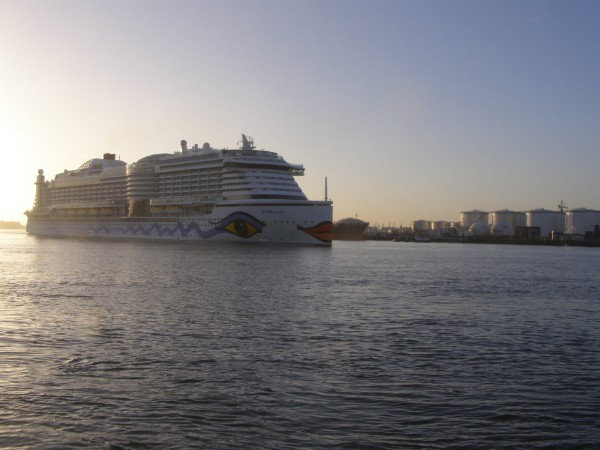
Construction and general statistics
The ships were going to be built in Japan, at the Mitsubishi Heavy Industries Yards at Nagasaki. They were not going to be built at the Meyer werft, where the Sphinx- and Ikarus-classes were built, mostly due to the full orderbook there so slots were not available for the near future. The ships were planned to be introduced in march 2015 and march 2016 and this was something Meyer Werft was unable to reach (mostly also due to the still to be built Ikarus-class of ships for AIDA itself). The ships were going to be built for a price of 455 million euro's and the keel for the first ship was laid under yardnumber 2300 at the Tategami-wharf at Nagasaki at the 30th of june of 2013. From the 8th of october of 2013, the real name of the ship was revealed and it was going to be the AIDAprima. This name kind of translated to 'The First', maybe because the ship was going to the companies flagship. For the second ship, the name that was often suggested was AIDAmia, meaning 'Mine'. Still unofficial, but maybe a blink to the Mein Schiff-series ('My Ship') from Royal Caribbean's German subsidiary TUI Cruises. Just a thought...
AIDAprima was going to measure 125.572 tons, so a huge step forward from the 70.000-ton Sphinx-class and Ikarus-class. The ship has 18 decks, a lenght of 299,95 meters, a width of 37,6 meters and a draught of 8 meters. Around 900 crewmembers are there to cater for 3250 passengers in 1643 cabins. The ship is propelled by two ABB-designed azipods creating a speed of around 22 knots and her energy comes from three diesel-engines of caterpilar-MAK design, and one caterpilar-MAK diesel-gasmotor.
Building the ships was not without problems, especially for the wharf, who created a loss of 1,7 billion US Dollars during the building of the Hyperion-class ships, especially because of problems the company faced in the design of the cabins, resulting in a long delay in the actual buildingtime and extra materials needed for construction. Because of those delays, the ship was not going to be delivered to AIDA Cruises on time and the company postponed delivery to october of 2015. Because of this, the ship's 86-day maiden voyage had to be cancelled. But this was not the end of the problems, as the ship was docked out at the 22nd of july of 2015 but her following trials at the end of july were not satisfactory and the ship wasn't ready to be handed over to AIDA Cruises on time again. For the second time, the delivery of the ship was delayed towards december of 2015. Because of this, the initially planned cruises in the Persian Gulf had also to be cancelled. Named as the main reasons for the second delay was the determination of the company to make the new ships as technologicly and environmentally advanced as possible, as well as to be sure the ships would meet the high standard that the company was planning them to achieve. But also the date of december 2015 was not going to be met and the delivery date was (finally) again delayed to march of 2016, the original planned deliverydate of the second ship of the class. Which, by the way, was delayed also itself by one year.
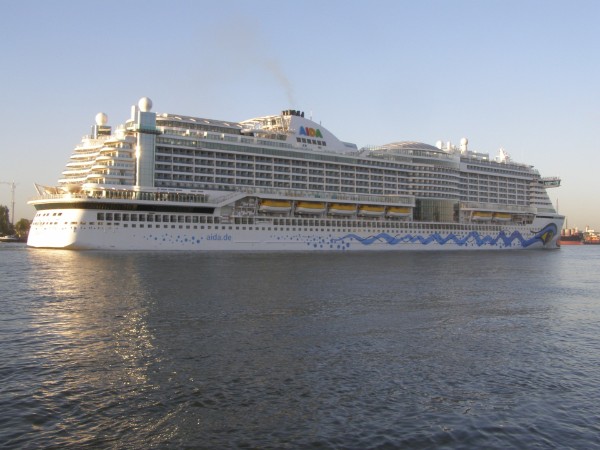
Last but not least, three times a fire broke out at deck 7 in january of 2016, adding to the delay. So we at least can say that the Hyperion-class of ships were not the most easy ships to built the last decades, probably coming close to the problematic Queen Elizabeth 2 introduction in 1968. That said, QE2 afterwards became one of the most beloved liners of all time and the longest serving transatlantic liner in history, so problems in the beginning do not always mean problems overall. AIDAprima was finally delivered to AIDA Cruises at the 14th of march of 2016 and she left the wharf on her way to Hamburg, where the ship will be homeported year-round for her European capitals cruise.
Structural design
The most obvious structural difference between the AIDAprima and all other cruiseships is the vertical stem. In the 19th century, the early steam-driven ships were all having a vertical stem, a true change from the clipperbowed sailingvessels from before. But during the 1920's, the stem slowly tilted and again recieved the clipper-style flare. This has been so ever since in all passengerships built. So the AIDAprima is a real traditionbreaker, or, better said, tradition-reviver. But it is not just only because they like to get attention for their new ship. Together with the Hamburgische Schiffbau Versuchsanstalt (that has been founded in 1914 with the backing of the Blohm & Voss Shipyards) AIDA Cruises developed this radical change. The HSV is a shipbuilding research & technology center where modeltests can be carried out and it was found that the normal design with a flared stem and a large bulbous bow is great for long distances, but as the AIDAprima was designed for shorter hauls between European capitals, mainly sailing at a slower speed in busy shippinglanes, this design was causing a high fuel consumption. To save fuel, and thus costs, the ship was going to be built like it is, with a straight stem and just a very small bulbous bow. Together with the slender hull design, water can flow more freely and faster in lower speeds, as the ship is designed for a servicespeed of just 17 knots instead of the normal 22.
On the picture below, AIDAprima's straight stem is shown, a unique designfeature in the worlds cruisingfleet.
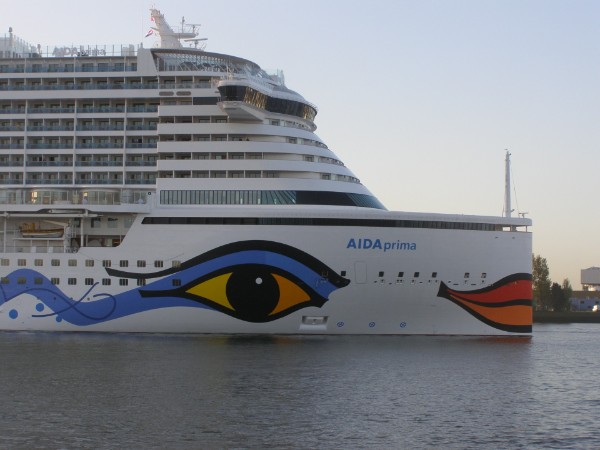
Next to the bowdesign, AIDAprima also is the first ship in the AIDA fleet that is driven by two ABB-designed pods, named XO-pods. Untill now, AIDA has watched carefully the development of pods and found out that the early versions were causing many troubles, like we have seen in the Celebrity Cruises Millennium-class of ships for example. With the new XO-pod, AIDA Cruises was confident and they have the guarantee that the ship will not have to dock for maintainance more then just every five years. Of course, there is also the better manouverability in contradiction with the traditional propeller, again saving fuel.
These are not the only innovations within AIDAprima. The Mitsubishi-wharf itself has developped a new system that blows airbubbles under the ships hull while sailing, creating less drag from the water as the ship technically floats on a cushen of air. The system is named MALS (Mitsubishi Air Lubrication System). This again reduces fuelconsumption by at least seven percent. With all those structural changes, AIDAprima will be the most fuel-efficient passengership built untill now, and although these innovations have delayed her introduction, it will truly be an advantage during her carreer. Above all, the ports of Hamburg, Rotterdam and Southampton are able to power the ship with LNG (Liquified Natural Gas) during portstays, which is the most environmentfriendly fuelsource for a ship at this moment. AIDAprima is the first ship in the world that is dually-fuelled with diesel and LNG.
Not to be forgotten, AIDAprima will also be fitted with the advanced shrudder-filtersystems for the emissions of soot-particles, nitrogenoxide and sulphuroxide, where all new Carnival Corporation ships will be designed with because this system is having huge environmental benefits. It is expected that it will reduce harmfull emissions with 90 to 99%.
Interiour design
This all of course is great for the environmentalists and owners of the ship, but also the passengers are not forgotten. The ship has at least 14 different cabincategories, including the so-called Lanai staterooms at deck 8 with a large veranda as well as a wintergarden. The doors to the wintergarden can be opened all the way to create a unique 32 square meter space. Next to those, the 36 Panorama Suites have their own sundeck, complete with bar and private waterlandscape.
A new feature is aboard is the AIDA Beach Club, that is a relaxarea in beachstyle, with sand and palmtrees where passengers can enjoy the sun in every kind of weather. This all is closed from the outside by a transparent and dome-shaped UV-permeable membrane. This membrane can also be used for the projection of starry skies and lasershows. Like aboard Princess Cruises newest Royal Princess, the ship also has a glass skywalk at a height of 45 meters, but aboard AIDAprima it is located at the ships stern. Of course also the Theatrium is back, but now larger then aboard the former ships, with a circular stage and with still better technology.
The theatrium of the Hyperion-class ships looks very different from the outside in contradiction to the Sphinx- and Ikarus classes.
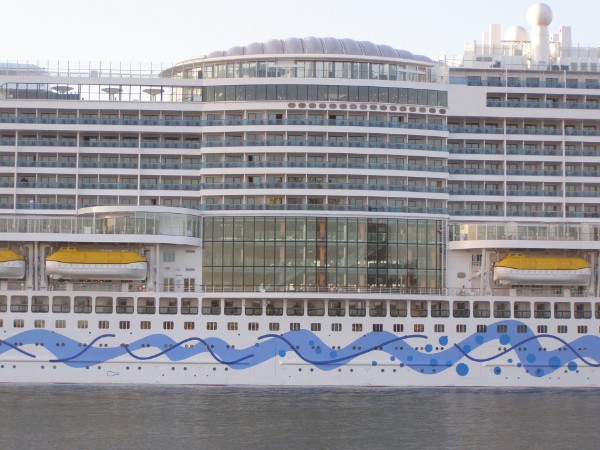
The Four Elements Deck is a deck devoted to, well, the four elements Water, Fire, Air and Earth. It provides many activities such as a rockclimbing wall and a waterslide, next to a gently flowing river where you can relax within your own floating rubber ring.
AIDA Plaza is the ships shopping district, that can also host streetartists or meetings and of course the ship cannot do without a very large wellness and fitness area, with sauna's, indoor and outdoor pools, a tepidarium and the Body & Soul Organic Spa.
In contradiction to other ships of the line, there are now 13 restaurants to choose from, of course there is no main restaurant and the four buffet-style restaurants are there, but now there are so much more specialityrestaurants to choose from. Those include French Kiss for French cuisine, Casa Nova for Mediterranean style dining and The Scharfe Ecke for typical German recipies with currywürst. For drinks, the ship offers 18 bars, one of which is of course the line's trademark AIDA Bar, where the bar is placed in the shape of a compass-rose, another one is the Spray Bar, a champagnebar that is operated together with Moët & Chandon. The Patiobar overlooks the ships bow, giving the same view as the captain and of course there also is a nightclub. All interiours, that are very spacious with the use of light, airy colours, are designed by the German firm Partner Ship Design, who are involved with all shipdesignes for the company.
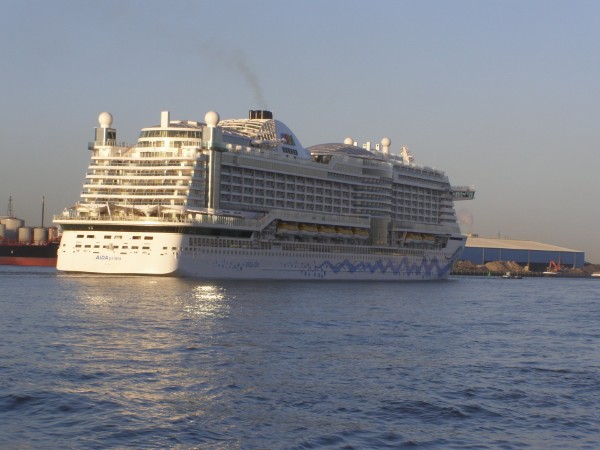
Delivery and naming
After her delivery at the 14th of march 2016, the ship departed for Hamburg with stops at Singapore, Salalah, Limassol, Cadiz and Rotterdam, the last one being one of her ports of call during her planned yearround cruise from Hamburg. This cruise will furthermore bring her to Southampton, England; Le Havre, France and Zeebrugge, Belgium. Passengers for this cruise have the opportunity to board the ship in Hamburg as well as Rotterdam, so in fact it is advertised as two different cruises. In the time during her delivery, AIDA Cruises also revealed the name for the second ship of the class, AIDAperla. As the company also ordered two still larger ships of around 180.000 tons, it is expected that no more ships in the Hyperion-class will be built after her.
At the 7th of may 2016, AIDAprima was named in the port of Hamburg by the youngest ever godmother in cruise history. The honour was for the just thirteen-year old German actress Emma Schweiger and she reflects the youthfull, fresh image of the company. The ceremony was also be attended by the AIDAaura and is the highlight of the 827th harbour anniversary. This huge maritime celebration was held between the 5th and 8th of may and is largely sponsored by AIDA Cruises due to the strong bond between the port and the cruiseline. The ceremony was again in an enormous scale as the Hamburg sky was filled with fireworks and the ship itself made into a large screen for a laser-lightshow, bringing also her young godmother in tears of excitement.

